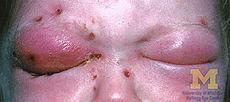- Orbital cellulitis
-
Orbital cellulitis Classification and external resources 
ICD-10 H05.0 ICD-9 376.01 DiseasesDB 9249 eMedicine article/1217858 MeSH D054517 Orbital cellulitis is an infection of eye tissues posterior to the orbital septum. It most commonly refers to an acute spread of infection into the eye socket from either the adjacent sinuses or through the blood. When it affects the rear of the eye, it is known as retro-orbital cellulitis.
It should not be confused with periorbital cellulitis, which refers to cellulitis anterior to the septum.
Contents
Signs and symptoms
Patients commonly complain of pain when moving the eye, sudden loss of vision, bulging of the eye or eyes that are infected and limited eye movement. Along with these symptoms, patients typically have redness and swelling of the eyelid, pain, discharge, inability to open the eye, occasional fever and lethargy. It is usually caused by a previous sinusitis. Other causes include infection of nearby structures, trauma and previous surgery.
Causes
Orbital cellulitis occurs commonly from bacterial infection spread by the paranasal sinuses. Other ways in which orbital cellulitis may occur is from infection in the blood stream and from an eyelid skin infection. Upper respiratory infection, sinusitis, trauma to the eye, ocular or periocular infection and systemic infection all increase one’s risk of orbital cellulitis.
Staphylococcus aureus, Streptococcus pneumoniae and beta-hemolytic streptococci are three bacteria that can be responsible for orbital cellulitis.
- Staphylococcus aureus, is a gram-positive bacterium which is the most common of staph infections. Staphylococcus aureus infection can spread to the orbit from the skin. Staph organisms are able to produce toxins which promote their virulence which leads to the inflammatory response seen in orbital cellulitis. Staphylococcus infections are identified by a cluster arrangement on gram stain. Staphylococcus aureus forms large yellow colonies (which is distinct from other Staph infections such as Staphylococcus epidermis which forms white colonies).
- Streptococcus pneumoniae, is also a gram-positive bacterium responsible for orbital cellulitis due to its ability to infect the sinuses (sinusitis). Strep organisms are able to determine their own virulence and can invade surrounding tissues causing an inflammatory response seen in orbital cellulitis (similar to Staphyloccoccus aureus). Streptococcal infections are identified on culture by their formation of pairs or chains. Streptococcus pneumoniae produce green (alpha) hemolysis, or partial reduction of red blood cell hemoglobin.
Treatment
Prompt treatment is vital for a patient when fighting orbital cellulitis. Treatment typically involves IV antibiotics in the hospital and frequent observation (every 4-6 hours). Along with this several laboratory tests are run including a complete blood count, differential, and would culture.
- Antibiotic Therapy - Since orbital cellulitis is commonly caused by Staphylococcus and Streptococcus species both penicillins and cephalosporins are typically the best choices for IV antibiotics. However, due to the increasing rise of MRSA (methicillin-resistant Staphylococcus aureus) orbital cellulitis can also be treated with Vancomycin, Clindamycin, or Doxycycline. If improvement is noted after 48 hours of IV antibiotics, healthcare professions can then consider switching a patient to oral antibiotics (which must be used for 2-3 weeks).
- Surgical Intervention - An abscess can threaten the vision or neurological status of a patient with orbital cellulitis, therefore sometimes surgical intervention is necessary. Surgery typically requires drainage of the sinuses and if a subperiosteal abscess is present in the medial orbit, drainage can be performed endoscopically. Post-operatively, patients must follow up regularly with their surgeon and remain under close observation.
Prognosis
Although orbital cellulitis is considered an ophthalmic emergency the prognosis is good if prompt medical treatment is received.
Complications
Complications include hearing loss, blood infection, meningitis, and optic nerve damage (which could lead to blindness).
References
- Nageswaran S, Woods CR, Benjamin DK, Jr., et al (2006). "Orbital cellulitis in children". Pediatr Infect Dis J 25 (8): 695-.
- Howe L, Jones N (2004). "Guidelines for the management of periorbital cellulitis/abscess". Clin Otolaryngol Allied Sci 29 (6): 725–8. doi:10.1111/j.1365-2273.2004.00889.x. PMID 15533168.
- Garcia GH, Harris GJ (2000). "Criteria for nonsurgical management of subperiosteal abscess of the orbit: analysis of outcomes". Ophthalmology 107 (8).
- Ferguson MP, McNabb AA (1999). "Current treatment and outcome in orbital cellulitis". Australian and New Zealand Journal of Ophthalmology 27 (6): 375–379.
- Noel LP, Clarke WN, MacDonald N (1990). "Clinical management of orbital cellulitis in children". Canadian Journal of Ophthalmology 25 (1): 11–16.
- Shapiro E, Wald E, Brozanski B (1982). "Periorbital cellulitis and paranasal sinusitis: a reappraisal". Pediatric Infectious Disease 1 (2).
External links
- University of Toronto
- MedlinePlus.
- Merck Manual.
- Handbook of Ocular Disease Management.
- Orbital Cellulitis Photos and Medical Notes Case Study.
- American Academy of Ophthamology
- Pub Med Health - Orbital Cellulitis
Infectious disease / Microbiology Disciplines/
pathogens/
major diseasesPeople Special topics Categories:- Bacterial diseases
- Disorders of eyelid, lacrimal system and orbit
Wikimedia Foundation. 2010.
